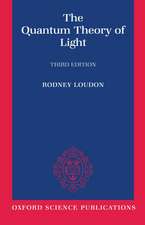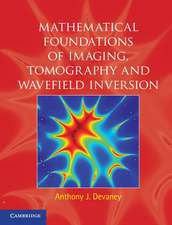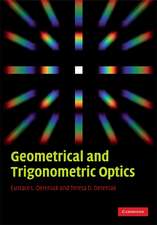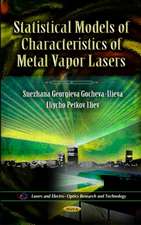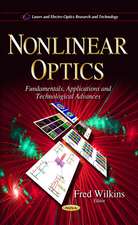Field Models in Electricity and Magnetism
Autor Paolo Di Barba, Antonio Savini, Slawomir Wiaken Limba Engleză Hardback – 27 feb 2008
| Toate formatele și edițiile | Preț | Express |
|---|---|---|
| Paperback (1) | 635.01 lei 6-8 săpt. | |
| SPRINGER NETHERLANDS – 19 oct 2010 | 635.01 lei 6-8 săpt. | |
| Hardback (1) | 641.20 lei 6-8 săpt. | |
| SPRINGER NETHERLANDS – 27 feb 2008 | 641.20 lei 6-8 săpt. |
Preț: 641.20 lei
Preț vechi: 754.36 lei
-15% Nou
Puncte Express: 962
Preț estimativ în valută:
122.71€ • 127.14$ • 102.41£
122.71€ • 127.14$ • 102.41£
Carte tipărită la comandă
Livrare economică 21 martie-04 aprilie
Preluare comenzi: 021 569.72.76
Specificații
ISBN-13: 9781402068423
ISBN-10: 1402068425
Pagini: 188
Ilustrații: X, 174 p.
Dimensiuni: 155 x 235 x 21 mm
Greutate: 0.44 kg
Ediția:2008
Editura: SPRINGER NETHERLANDS
Colecția Springer
Locul publicării:Dordrecht, Netherlands
ISBN-10: 1402068425
Pagini: 188
Ilustrații: X, 174 p.
Dimensiuni: 155 x 235 x 21 mm
Greutate: 0.44 kg
Ediția:2008
Editura: SPRINGER NETHERLANDS
Colecția Springer
Locul publicării:Dordrecht, Netherlands
Public țintă
ResearchCuprins
1 Introduction
2 Vector fields
2.1 Basic operators and equations
2.1.1 Vector fields and operators
2.1.2 Definition of a vector field
2.1.3 Decomposition of a field
2.1.4 Scalar and vector potentials
2.1.5 Green’s theorem
2.1.6 Green’s formula
2.2 Electrostatic field
2.2.1 Maxwell’s equations for electrostatics
2.2.2 Electrostatic potentials
2.2.3 Electrostatic energy
2.2.4 Field of a charged plane (rectangular domain)
2.2.5 Field of a point charge in R3 (spherical domain)
2.2.6 Field of a dipole of moment d q p = in R3
2.2.7 Field of a line charge in R3 (cylindrical domain)
2.2.8 Field of a surface charge on a sphere of radius a with density s
2.2.9 Energy and forces in the electrostatic field
2.2.10 Force between the plates of a capacitor
2.2.11 Force at the interface between two dielectric materials
2.3 Magnetostatic field
2.3.1 Maxwell’s equations for magnetostatics
2.3.2 Magnetostatic potentials
2.3.3 Magnetostatic energy
2.3.4 Field of a line current in R3
2.3.5 Energy and forces in the magnetostatic field
2.3.6 Force on an electromagnet
2.3.7 Test problems
2.4 Steady conduction field
2.4.1 Maxwell’s equations for conduction field
2.4.2 Potentials
2.4.3 Power loss
2.4.4 Analytic functions of complex variable
2.4.5 Field of a cylindrical conductor in R3
3 Analytical methods of solving boundary value problems
3.1 Method of Green’s functions
3.1.1 Green’s formula for electrostatics
3.1.2 Field of a point charge q surrounded by a sphere of radius a with U = 0
3.1.3 Field of a point charge q surrounded by a sphere of radius a with U = k
3.1.4 Field of a surface dipole distributed on a sphere of radius a with dipole densityt
3.1.5 Green’s formula for two-dimensional magnetostatics
3.2 Method of images
3.2.1 Magnetic field of a line current in a slot
3.2.2 Magnetic field of an AC line current over a conducting half-space
3.3 Method of separation of variables
3.3.1 Magnetic field of a current uniformly distributed in a slot
4 Numerical methods of solving boundary value problems
4.1 Variational formulation in magnetostatics
4.2 Finite elements for two-dimensional magnetostatics
4.2.1 Discretization of energy functional
4.2.2 Local shape functions
4.2.3 Coefficient matrix and source vector
4.2.4 From potential to field
4.2.5 Magnetic field in a slot solved by the finite element method
4.3 Finite elements for three-dimensional magnetostatics
5 Time-varying electromagnetic field
5.1 Maxwell’s equations in differential form
5.2 Poynting’s vector
5.3 Maxwell’s equations in frequency domain
5.4 Plane waves in an infinite domain
5.5 Wave and diffusion equations in terms of vectors E and H
5.6 Wave and diffusion equations in terms of scalar and vector potentials
5.7 Electromagnetic field radiated by an oscillating dipole
5.8 Diffusion equations in terms of dual potentials
5.9 Weak eddy current in a conducting plane under a.c. conditions
5.10 Strong eddy current in a conducting plane under a.c. conditions
5.11 Eddy current in a cylindrical conductor under step excitation
5.12 Electromagnetic field equations in different reference frames
6 Inverse problems
6.1 Direct and inverse problems
6.2 Well-posed and ill-posed problems
6.3 Fredholm’s integral equation of the first kind
6.4 Case study: synthesis of magnetic field sources
6.5 Under- and over-determined systems of equations
6.6 Least-squaressolution
6.7 Classification of inverse problems
7 Optimization
7.1 Solution of inverse problems by the minimization of a functional
7.2 Constrained optimization
7.3 Gradient–free and gradient-based methods
7.4 Deterministic vs non-deterministic search
7.5 A deterministic algorithm of lowest order: simplex method
7.6 A non-deterministic algorithm of lowest order: evolution strategy
7.7 Numerical case studies
7.7.1 Identification of B-H curve of the iron region of a magnetic pole
7.7.2 Shape design of a magnetic pole (static optimisation)
7.7.3 Shape design of a magnetic pole (dynamic optimisation)
7.7.4 A multiobjective approach to the shape design of a magnetic pole
2 Vector fields
2.1 Basic operators and equations
2.1.1 Vector fields and operators
2.1.2 Definition of a vector field
2.1.3 Decomposition of a field
2.1.4 Scalar and vector potentials
2.1.5 Green’s theorem
2.1.6 Green’s formula
2.2 Electrostatic field
2.2.1 Maxwell’s equations for electrostatics
2.2.2 Electrostatic potentials
2.2.3 Electrostatic energy
2.2.4 Field of a charged plane (rectangular domain)
2.2.5 Field of a point charge in R3 (spherical domain)
2.2.6 Field of a dipole of moment d q p = in R3
2.2.7 Field of a line charge in R3 (cylindrical domain)
2.2.8 Field of a surface charge on a sphere of radius a with density s
2.2.9 Energy and forces in the electrostatic field
2.2.10 Force between the plates of a capacitor
2.2.11 Force at the interface between two dielectric materials
2.3 Magnetostatic field
2.3.1 Maxwell’s equations for magnetostatics
2.3.2 Magnetostatic potentials
2.3.3 Magnetostatic energy
2.3.4 Field of a line current in R3
2.3.5 Energy and forces in the magnetostatic field
2.3.6 Force on an electromagnet
2.3.7 Test problems
2.4 Steady conduction field
2.4.1 Maxwell’s equations for conduction field
2.4.2 Potentials
2.4.3 Power loss
2.4.4 Analytic functions of complex variable
2.4.5 Field of a cylindrical conductor in R3
3 Analytical methods of solving boundary value problems
3.1 Method of Green’s functions
3.1.1 Green’s formula for electrostatics
3.1.2 Field of a point charge q surrounded by a sphere of radius a with U = 0
3.1.3 Field of a point charge q surrounded by a sphere of radius a with U = k
3.1.4 Field of a surface dipole distributed on a sphere of radius a with dipole densityt
3.1.5 Green’s formula for two-dimensional magnetostatics
3.2 Method of images
3.2.1 Magnetic field of a line current in a slot
3.2.2 Magnetic field of an AC line current over a conducting half-space
3.3 Method of separation of variables
3.3.1 Magnetic field of a current uniformly distributed in a slot
4 Numerical methods of solving boundary value problems
4.1 Variational formulation in magnetostatics
4.2 Finite elements for two-dimensional magnetostatics
4.2.1 Discretization of energy functional
4.2.2 Local shape functions
4.2.3 Coefficient matrix and source vector
4.2.4 From potential to field
4.2.5 Magnetic field in a slot solved by the finite element method
4.3 Finite elements for three-dimensional magnetostatics
5 Time-varying electromagnetic field
5.1 Maxwell’s equations in differential form
5.2 Poynting’s vector
5.3 Maxwell’s equations in frequency domain
5.4 Plane waves in an infinite domain
5.5 Wave and diffusion equations in terms of vectors E and H
5.6 Wave and diffusion equations in terms of scalar and vector potentials
5.7 Electromagnetic field radiated by an oscillating dipole
5.8 Diffusion equations in terms of dual potentials
5.9 Weak eddy current in a conducting plane under a.c. conditions
5.10 Strong eddy current in a conducting plane under a.c. conditions
5.11 Eddy current in a cylindrical conductor under step excitation
5.12 Electromagnetic field equations in different reference frames
6 Inverse problems
6.1 Direct and inverse problems
6.2 Well-posed and ill-posed problems
6.3 Fredholm’s integral equation of the first kind
6.4 Case study: synthesis of magnetic field sources
6.5 Under- and over-determined systems of equations
6.6 Least-squaressolution
6.7 Classification of inverse problems
7 Optimization
7.1 Solution of inverse problems by the minimization of a functional
7.2 Constrained optimization
7.3 Gradient–free and gradient-based methods
7.4 Deterministic vs non-deterministic search
7.5 A deterministic algorithm of lowest order: simplex method
7.6 A non-deterministic algorithm of lowest order: evolution strategy
7.7 Numerical case studies
7.7.1 Identification of B-H curve of the iron region of a magnetic pole
7.7.2 Shape design of a magnetic pole (static optimisation)
7.7.3 Shape design of a magnetic pole (dynamic optimisation)
7.7.4 A multiobjective approach to the shape design of a magnetic pole
Textul de pe ultima copertă
Covering the development of field computation in the past forty years, Field Models in Electricity and Magnetism intends to be a concise, comprehensive and up-to-date introduction to field models in electricity and magnetism, ranging from basic theory to numerical applications.
The approach assumed throughout the whole book is to solve field problems directly from partial differential equations in terms of vector quantities.
Theoretical issues are illustrated by practical examples. In particular, a single example is solved by different methods so that, by comparison of results, limitations and advantages of the various methods are made clear.
The subjects of the synthesis of fields and of the optimal design of devices, which are growing in research and so far have not been adequately covered in textbooks, are developed in addition to more classical subjects of analysis.
Topics covered include:
The approach assumed throughout the whole book is to solve field problems directly from partial differential equations in terms of vector quantities.
Theoretical issues are illustrated by practical examples. In particular, a single example is solved by different methods so that, by comparison of results, limitations and advantages of the various methods are made clear.
The subjects of the synthesis of fields and of the optimal design of devices, which are growing in research and so far have not been adequately covered in textbooks, are developed in addition to more classical subjects of analysis.
Topics covered include:
- vector fields: electrostatics, magnetostatics, steady conduction;
- analytical methods for solving boundary-value problems;
- numerical methods for solving boundary-value problems;
- time-varying electromagnetic field;
- inverse problems;
- optimization.
Caracteristici
A self-contained and up-to-date introduction to field modelling in electricity and magnetism Directly solves field problems from field equations in terms of vector quantities Comprehensive and including synthesis, in addition to analysis, of fields Based on a problem-solving-approach which offers a practical example solved by various methods

